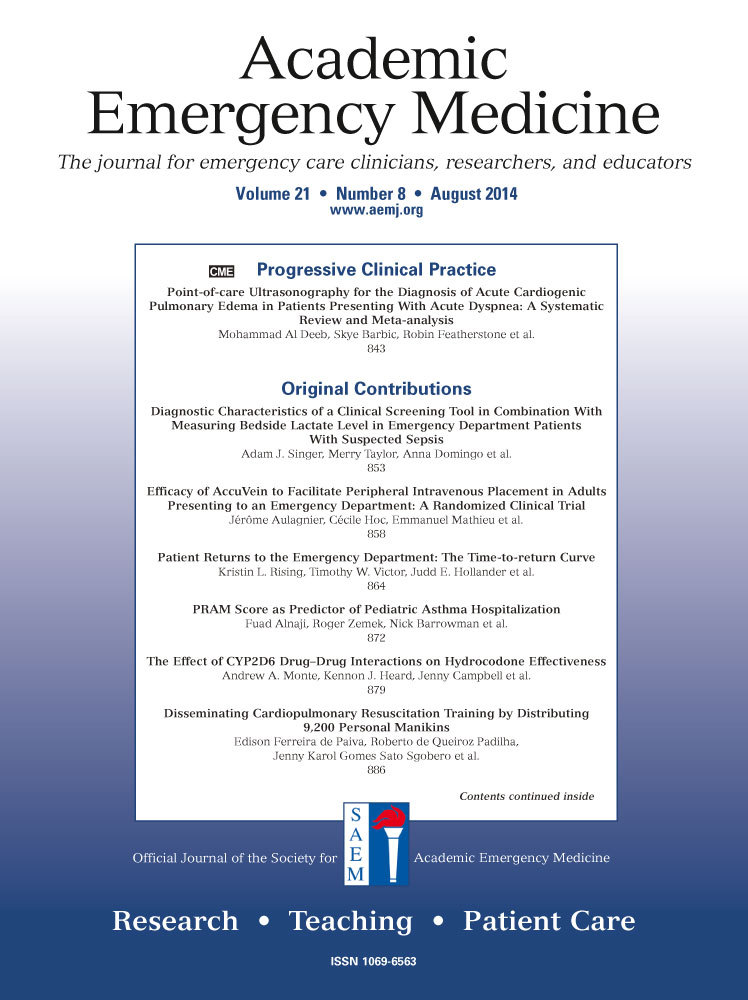The Relationship Between a Chief Complaint of “Altered Mental Status” and Delirium in Older Emergency Department Patients
La Relación entre el Motivo de Consulta Principal “Estado Mental Alterado” y el Delirium en los Pacientes Mayores en el Servicio de Urgencias
Abstract
enBackground
Altered mental status is a common chief complaint among older emergency department (ED) patients. Patients with this chief complaint are likely delirious, but to the authors' knowledge, this relationship has not been well characterized. Additionally, health care providers frequently ascribe “altered mental status” to other causes, such as dementia, psychosis, or depression.
Objectives
The objective was to determine the relationship between altered mental status as a chief complaint and delirium.
Methods
This was a secondary analysis of a cross-sectional study designed to validate three brief delirium assessments, conducted from July 2009 to March 2012. English-speaking patients who were 65 years or older and in the ED for <12 hours were included. Patients who were comatose or nonverbal or unable to follow simple commands prior to the acute illness were excluded. Chief complaints were obtained from the ED nurse triage assessment. The reference standard for delirium was a comprehensive psychiatrist assessment using the Diagnostic and Statistical Manual of Mental Disorders, Fourth Edition, Text Revision criteria. Sensitivity, specificity, positive likelihood ratio (LR), and negative LR with their 95% confidence intervals (CIs) were calculated using the psychiatrist's assessment as the reference standard.
Results
A total of 406 patients were enrolled. The median age was 73.5 years old (interquartile range [IQR] = 69 to 80 years), 202 (49.8%) were female, 57 (14.0%) were nonwhite race, and 50 (12.3%) had delirium. Twenty-three (5.7%) of the cohort had chief complaints of altered mental status. The presence of this chief complaint was 38.0% sensitive (95% CI = 25.9% to 51.9%) and 98.9% specific (95% CI = 97.2% to 99.6%). The negative LR was 0.63 (95% CI = 0.50 to 0.78), and the positive LR was 33.82 (95% CI = 11.99 to 95.38).
Conclusions
The absence of a chief complaint of altered mental status should not reassure the clinician that delirium is absent. This syndrome will be missed unless it is actively looked for using a validated delirium assessment. However, patients with this chief complaint are highly likely to be delirious, and no additional delirium assessment is necessary.
Resumen
esIntroducción
El estado mental alterado (EMA) es un motivo de consulta principal frecuente en pacientes mayores que consultan al servicio de urgencias (SU). Este motivo de consulta principal en estos pacientes corresponde con más frecuencia a delirium, pero según el conocimiento de los autores, esta relación no ha sido bien caracterizada. Además, los sanitarios frecuentemente relacionan EMA a otras causas, como la demencia, la psicosis o la depresión.
Objetivos
El objetivo fue determinar la relación entre EMA como motivo de consulta principal y el delirium.
Metodología
Análisis secundario de un estudio transversal diseñado para validar tres valoraciones breves de delirium, llevado a cabo de julio de 2009 a marzo de 2012. Se incluyeron los pacientes de habla inglesa que tenían 65 años o más de edad y que estuvieron menos de 12 horas en el SU. Se excluyeron los pacientes en coma o que tenían demencia en estadio terminal. Los motivos de consulta principales se obtuvieron de la valoración del triaje de enfermería del SU. El estándar de referencia de delirium fue una valoración psiquiátrica global usando los criterios revisados DSM-IV (Diagnostic and Statistical Manual of Mental Disorders, cuartra edición). Se calculó la sensibilidad, la especificidad, la razón de probabilidad positiva y la razón de probabilidad negativa con sus intervalos de confianza al 95% usando la valoración del psiquiatra como estándar de referencia.
Resultados
Se incluyeron un total de 406 pacientes. La mediana de edad fue de 73,5 años (rango intercuartílico: 69 a 80 años), 202 (50%) fueron mujeres, 57 (14%) de raza no blanca y 50 (12,3%) tuvieron delirium. Veintitrés pacientes (5,7%) de la cohorte tuvieron como motivo de consulta principal EMA. La presencia de este motivo de consulta principal tuvo una sensibilidad de un 38,0% (IC 95% = 25,9% a 51,9%) y una especificidad de un 98,9% (IC 95%= 97,2% a 99,6%). La razón de probabilidad negativa fue 0,63 (IC 95% = 0,50 a 0,78) y la razón de probabilidad positiva fue 33,82 (IC 95% = 11,99 a 95,38).
Conclusiones
La ausencia de un motivo de consulta de EMA no debería hacer pensara al clínico que el delirium está ausente. El diagnóstico de este síndrome se perderá a menos que se busque activamente usando un valoración validada de delirium. Sin embargo, los pacientes con EMA como motivo de consulta principal es más probable que padezcan delirium y que no sea necesaria una valoración de delirium adicional.




